Ceramic braces are a popular alternative to traditional metal since they are just as effective but much less noticeable, being made from a clear or tooth-coloured material. This makes them a great option for people who want a straighter smile without it being quite so obvious they’re wearing braces.
But how much do ceramic braces cost in the UK? You can expect to pay more for ceramic braces vs metal, but for many people it’s worth the price.
In this guide we will look at ceramic brace prices, what brands are available in the UK, and the pros and cons compared with other types of dental braces like clear aligners and traditional metal braces.
We hope you find all the information you need to make up your mind about whether this is the right orthodontic treatment for you.

- Virtually Invisible: Enjoy the discretion of clear aligners without brackets or wires.
- Home Convenience: Start from home with an easy assessment and custom aligner kit.
- Wear Time Flexibility: Optimal results with 22+ hours daily wear, changing aligners every 2-3 weeks.
- Cost-Effective: Save up to 75% compared to traditional braces.
- Safe Materials: BPA and latex-free for your health and comfort.
- Quick Results: See changes in just 4-6 months.
- Transform your smile today with NewSmile: Discover More
What are ceramic braces?
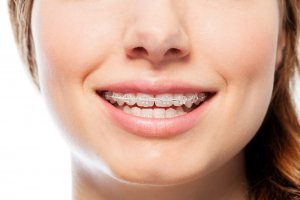
Think traditional metal braces, only made from a white or clear material so they are less obvious.
Fixed ceramic brackets are bonded to each tooth and connected with an archwire. Sometimes the wire is also tooth-coloured (or ‘frosted’) so the entire appliance blends in with the teeth. Small elastic bands called ‘ligatures’ hold the wire in place on each bracket – and they are usually the same colour as the brackets as well.
During orthodontic treatment you will need to have checkups every 6-10 weeks. At these visits your orthodontist will check the progress of your treatment and make adjustments to the wire to keep your teeth moving in the right direction. Total treatment time is usually around 18 months but this depends on the amount of correction needed.

Patients often find their teeth are a little sore for a day or two after their braces are tightened, but aside from that there should be minimal discomfort.
Some ceramic braces use self-ligating technology. This allows the wire to automatically tighten and adjust itself, making the treatment process smoother on the teeth. It also means that no ligatures are needed since the brackets themselves clasp the wire.
Ceramic fixed braces come with a range of benefits:
- Discreet way to straighten teeth
- Suitable for both teenagers and adults
- Can treat a wide variety of teeth alignment problems, including severe malocclusion
- The ceramic material is strong and won’t chip or break easily
Many people undergo orthodontic work because they feel self-conscious about their uneven teeth. But as well as the aesthetic benefits, straighter teeth are easier to clean. So any investment in braces is also an investment in your oral hygiene for the future.
Ceramic vs. metal braces
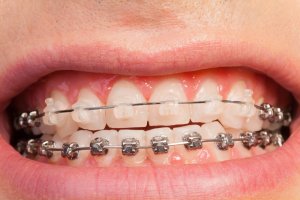
Whether you choose ceramic or metal braces, the components are essentially the same, as are the treatment method and end results. The difference with ceramic braces vs metal is that the material used for the brackets is a clear, white or tooth-coloured ceramic. This means the braces blend in with the teeth and are much less obvious from a distance.
Around 75% of UK orthodontists offer a choice of metal or ceramic braces.
Although still noticeable close-up, the better aesthetics of ceramic brackets can help people feel more confident about wearing braces. Teenagers and kids who need braces avoid any “metal mouth” taunts in the playground, while adults at work might feel that clear braces make them look more professional.
One of the biggest fears orthodontic patients have, young and old, is the prospect of having a mouth full of metal. It changes your look. So if a less visibly jarring alternative to traditional metal braces exists, why aren’t ceramic braces the universal choice for treatment?
There are a few things to keep in mind about patients and their braces. Braces become part of the patient and many young patients prefer to make a choice. Metal braces are often a personal statement.
There are styles of braces: ordinary squares, stars, hearts, flowers, balls, super-diamonds and even Disney’s Mickey Mouse by WildSmiles braces. These stainless steel braces are noted for the opportunity to pick colour ties to attach the wire.
Sometimes ceramic braces are offered with an extra fee. The elastic ties that hold the wire to the brackets can be stained by food and drinks and be more noticeable with ceramic braces than metal.
Another factor to consider is that it may take longer for your teeth to move into place with ceramic braces because they’re more fragile and require more care by your orthodontist.
All of that being said, ceramic braces are a great option for many patients. They get the job done and they’re less noticeable.
Dr. Clarke Stevens, Braces Omaha
Because of the more advanced materials used, usually ceramic braces cost more than metal. Wearers may also have to restrict what they eat in order to avoid staining the clear or white ligatures. Apart from these two things, there are no real drawbacks compared to traditional braces.
Combining metal and ceramic braces
In this video, one patient offers some insight into the difference between ceramic and metal braces. As you’ll see, she has clear ceramic braces on her top jaw and metal on her bottom jaw.
Patients may get this combination of braces for financial reasons; ceramic brackets cost more than metal so it’s more affordable to only get ceramic on the top jaw, which is the most visible.
Equally, dentists might choose not to fit white braces on the bottom jaw for practical reasons if you have a deep bite. The ceramic material is stronger than teeth, which means teeth can chip if they knock against brackets on the lower jaw. Metal brackets don’t pose this problem.
Be aware that both types (and all braces, in fact) require special attention when it comes to cleaning them and your teeth. Your dentist will show you the best tools and techniques for removing food and bacteria in tricky places. This small inconvenience is worth it to ensure your teeth don’t get stained or damaged while wearing braces.
Alternatives to ceramic braces
Ceramic braces are not the only option if you want something less noticeable than metal. In fact, there are other types of brace which are even less noticeable and have additional benefits.
Ceramic braces vs Invisalign
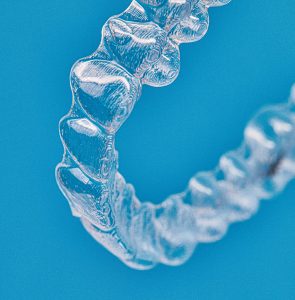
If you’re after an even more discreet way to straighten your teeth, there is the option of Invisalign invisible braces. These use a different system consisting of a series of clear plastic aligners which fit over the teeth.
These are a good alternative to ceramic braces since they are almost completely invisible to the casual observer with the added bonus of being removable. However, you must have the self-control to wear them for 20-22 hours per day.
Invisalign treatment is suitable for 90% of orthodontic cases and the price is usually equal to or lower than ceramic braces.
There is no fixed cost for ceramic braces or Invisalign treatment, so it’s best to visit a dentist or orthodontist for a personalised quote.
Lingual braces
Alternatively, you might consider lingual braces. Although made from metal, they are hidden behind the teeth so are very hard to detect. They can also be completely custom-made to offer more accurate results. The downside is they usually cost a lot more than other options.
You can read our complete guide to braces for adults for more information about the different types available.
Types of ceramic brace
Clear ceramic braces
Clear braces can be made from either plastic (polycarbonate), ceramic, or sapphire. The aluminium compound most often used in clear ceramic brackets is more durable and stain-resistant than polycarbonate.
If your teeth are naturally very white, clear ceramic braces are probably the best choice for you. The transparent material practically disappears on the surface of the teeth.
Clear ceramic brackets shouldn’t stain easily, but clear ligatures may. While these are changed at every checkup, you should still take extra precautions with what you eat and drink to limit any potential for staining. You can read more about this towards the end of the article.
White ceramic braces
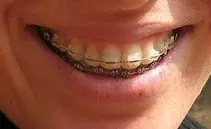
better on slightly yellow teeth
Despite being referred to as ‘white braces’, these brackets are actually designed to be tooth-coloured. If they were pure white, they would just draw attention to the fact that our teeth are naturally a bit yellow. But ‘off-white ceramic braces’ doesn’t sound as good, does it?
White ceramic braces look best against teeth that are a slightly darker shade. You can also get these ceramic braces with a white wire, rather than metal, to make them even less noticeable.
A different aluminium compound is used to create the whitish colour of these brackets. With certain brands, it’s possible to get brackets made to match the shade of your teeth. Others come in standard shades that may not be an exact match.
As with clear braces, the brackets themselves won’t stain but the elastics might do.
Coloured ceramic braces
Although many people choose ceramic braces because they want them to be as inconspicuous as possible, there’s nothing to stop you from jazzing them up with coloured ligatures. Just like coloured metal braces, you can personalise them by choosing from a range of coloured elastics.
Ligatures are replaced at every visit so you’ll have plenty of chances to change your look.
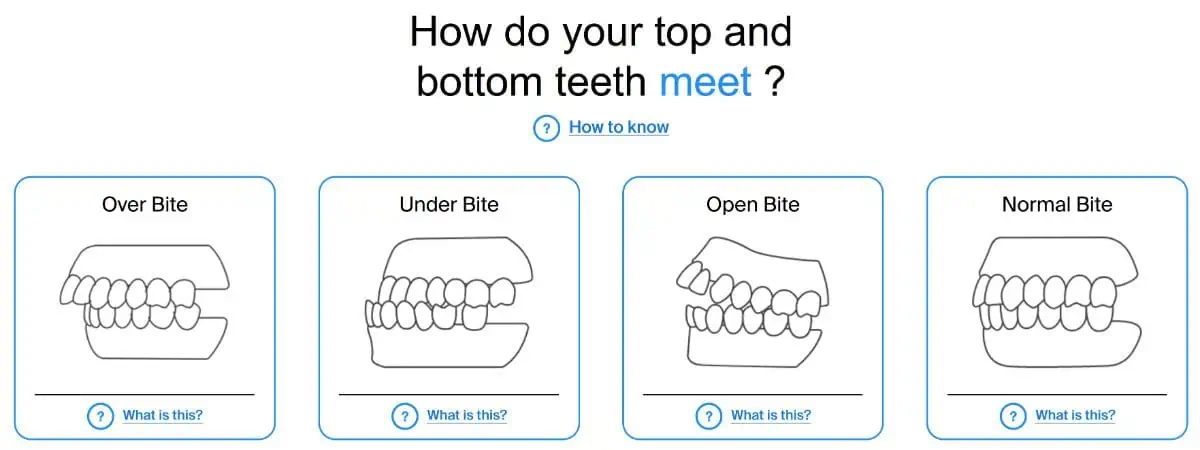
Ceramic brace brands in the UK
Different dentists choose to work with different brands of braces for different reasons. For instance, things like the price, availability, quality, comfort, ease of fitting and removal, or customer service may influence their decision.
Some of the most common brands of ceramic brace available in the UK include:
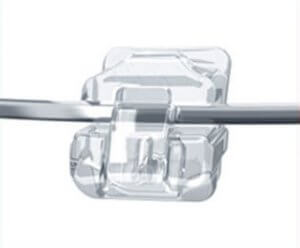
- Damon Clear
- Radiance Plus
- Clarity (ADVANCED and SL)
- InVu
Most dentists offer just one brand – possibly two. If you are set on a specific brand for whatever reason, you may need to look beyond your local clinic.
Below is a brief overview of the features and unique aspects of these brands:
Damon Clear
Damon Clear braces use a self-ligating system which eliminates elastic ties – meaning they are unlikely to stain. Many patients find self-ligating braces more comfortable as teeth move gradually under constant pressure, rather than braces being tightened in stages.
This system may also result in a slightly reduced treatment time and fewer checkups along the way. This makes them a popular choice for people who want faster results with a convenient schedule.
Radiance Plus
Radiance braces, from American Orthodontics, are extremely strong since they are made of sapphire (the next strongest thing to diamond). With their glass-like appearance, many dentists say they are the clearest braces available on the market. It shouldn’t come as a surprise they are also one of the most costly.
Clarity
The Clarity system from 3M uses translucent tooth-coloured brackets which are specially designed for comfort and ease of removal when treatment is complete. They have standard and self-ligating options.
InVu

These braces are not only tooth-coloured; they are made to match the colour of your teeth. They also come with tooth-coloured wires as standard. This is a metal wire coated in Teflon, so it’s possible for the coating to chip or become scratched, revealing the metal underneath.
Quick Straight Teeth
As the name suggests, the main selling point of Quick Straight Teeth is the treatment speed. It takes just four to six months on average, and they offer both ceramic braces and clear aligners. Their treatment focuses on just the front six to eight teeth, which is what makes it faster.
QST can be a cheaper alternative to other “full service” braces and aligners, but you’ll need to visit one of their partner dentists to get a quote. It works out quite a bit more than at-home solutions like Straight My Teeth which also provide fast cosmetic straightening but don’t involve the cost and inconvenience of dental checkups.
What do ceramic braces cost in the UK?
Ceramic braces cost between £3,000 and £7,000 on average, depending on the complexity and duration of your treatment. The brand of ceramic braces will also affect the price. Self-ligating brackets tend to cost a little more, for instance.
There is no fixed price for any kind of private dental treatment since every dentist is free to set their own rates. The following table shows approximate ceramic braces prices in the UK for the most popular brands.
Ceramic braces brand | Cost per arch | Material | Self-ligating? |
Radiance Plus | £1,800 - £4,000 | Clear | No |
Damon clear | £1,500 - £2,750 | Clear | Yes |
Clarity SL | £1,700 - £3,700 | Translucent tooth-coloured | Yes |
Clarity Advanced | £1,900 - £3,500 | Translucent tooth-coloured | No |
InVu | £1,800 - £3,200 | Tooth-coloured (colour match) | No |
These prices for ceramic teeth braces are indicative only, and are for a single arch (top or bottom teeth). We recommend you get quotes from 2-3 dentists if possible. This will give you a better idea of rates in your area for the treatment you need.
In the UK, if you want ceramic braces for you or your teen you will need to pay for private treatment. Metal braces, on the other hand, are provided on the NHS to under-18s and some adults who have a clinical need for them.
How much more are ceramic braces than traditional metal?
Because of the special materials used, ceramic braces cost more than metal in most cases. The exact price difference will again depend on the brand you choose and the length of your treatment.
As a general rule, we can say that adult ceramic braces prices in the UK are around 25-50% more than metal braces. But the best way to know for sure is to visit a dentist and get a quote for both.
Life with ceramic braces
In many ceramic braces reviews, wearers report feeling less self-conscious about wearing this style of braces.
But remember that they are still visible to some degree. Because people are less familiar with clear and white braces, they may actually take a longer glance at your mouth to work out what is in there. With metal brackets, on the other hand, there is less curiosity.
Do ceramic braces stain?
The material used for the brackets is designed to be stain-resistant. However, there is a possibility that the elastic bands placed on each bracket will become stained from certain foods and drinks.
If you’re paying the extra for ceramic fixed braces that blend in with your teeth, it’s worth making an effort to keep them that way. This means brushing and rinsing your teeth after every meal and flossing every day or using interdental brushes. Your dentist can advise you on the best tools to clean between and around your braces.
You’ll also want to avoid or limit your consumption of foods and drinks that can cause ligatures to stain. These include:
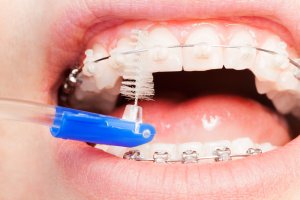
- Coffee and tea
- Red wine
- Dark fizzy drinks like cola
- Tomatoes and tomato-based sauces
- Brightly coloured sweets
- Soy sauce and balsamic vinegar
- Curries
- Berries such as raspberries, blueberries and blackberries
This is in addition to any foods your dentist tells you to avoid in order to protect your braces (usually chewy, crunchy and hard foods). Smoking will also stain your braces (and cause general oral health issues) so if you’re a smoker, try to quit.
If your ligatures do become discoloured, you’ll only have to live with it for a few weeks as they are changed at every visit. Make sure you keep up with your appointment schedule – the longer you leave in between visits, the greater the chance of staining.
Of course, if you choose a self-ligating appliance, you won’t have any ligatures to worry about. Cleaning as advised by your dentist should be enough to prevent ceramic brackets from staining.
Conclusion
If you’re deciding between ceramic braces or metal, your choice will come down to budget and aesthetics, since they both function in the same way.
Whichever type of braces you choose, we hope this article has helped you make the right decision about how to get your teeth straightened.
Always keep in mind that it’s recommended that you consult your dentist before starting any treatment to make sure it is right for you, and that there are no other dental issues that need addressing first.

- Virtually Invisible: Enjoy the discretion of clear aligners without brackets or wires.
- Home Convenience: Start from home with an easy assessment and custom aligner kit.
- Wear Time Flexibility: Optimal results with 22+ hours daily wear, changing aligners every 2-3 weeks.
- Cost-Effective: Save up to 75% compared to traditional braces.
- Safe Materials: BPA and latex-free for your health and comfort.
- Quick Results: See changes in just 4-6 months.
- Transform your smile today with NewSmile: Discover More
FAQs
How much do ceramic braces cost in the UK?
Ceramic braces prices in the UK range from about £1,500 to £4,000 per arch. You may combine ceramic on the upper arch with metal on the lower arch to keep the cost down.
Can you get ceramic braces on the NHS?
No, only metal braces are available on the NHS, and even then you will need to meet various criteria which make the braces medically necessary. Most adults can’t get NHS braces at all.
Which is better, ceramic or metal braces?
This really depends on whether you are willing to pay more for a less noticeably style. Your treatment will feel much the same whichever one you choose, and will be completed in around the same time.
If you want to pay as little as possible, choose metal. If aesthetics are your main concern, consider ceramic or invisible braces.
How can you keep ceramic braces white?
Ceramic brace brackets are designed to be stain-resistant, but the elastics used on them may stain. Avoid smoking and keep up a good oral hygiene routine to keep ceramic braces clean. Also be aware of the foods that are most likely to stain your teeth and braces.
British Orthodontics Society https://www.bos.org.uk/Public-Patients/Orthodontics-for-Children-Teens/Treatment-brace-types/Fixed-appliances/Conventional Consulted 24th April
National Center for Biotechnology Information https://www.ncbi.nlm.nih.gov/pmc/articles/PMC5198460/ Consulted 24th April
IntechOpen https://cdn.intechopen.com/pdfs/62469.pdf Consulted 24th April




